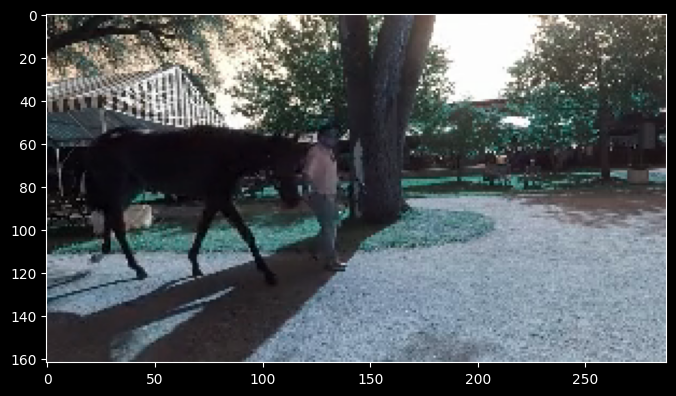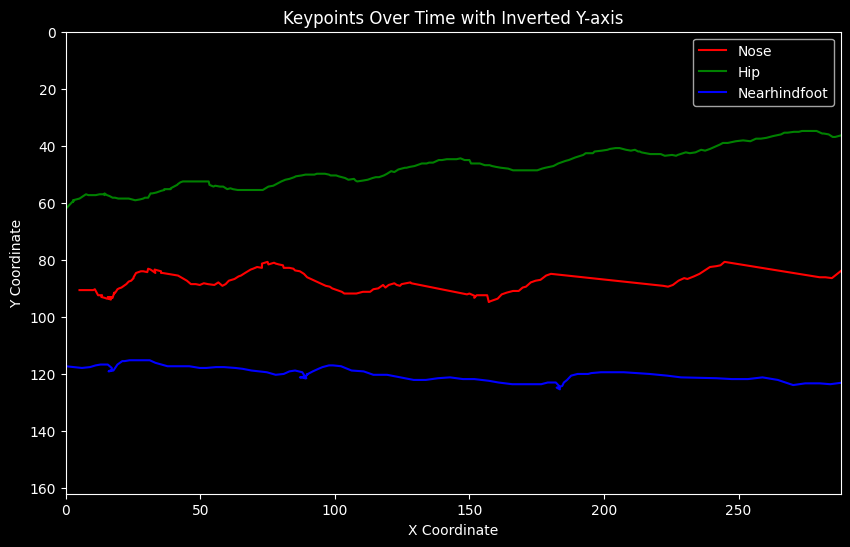AmadeusGPT Demo: Horse Gait Analysis#
please get an openAI user key: https://platform.openai.com/api-keys.
We suggest to run the demos locally, but it can be viewed on Google Colab. Some interactive features might not be available.
!pip install --pre amadeusgpt
Let’s test that your open AI API Key works:
mykey = "your-key-here"
import os
if 'OPENAI_API_KEY' not in os.environ:
os.environ['OPENAI_API_KEY'] = mykey
from openai import OpenAI
client = OpenAI(api_key=mykey)
response = client.chat.completions.create(
model="gpt-4",
messages=[{"role": "user", "content": "Hello AmadeusGPT"}]
)
print(response.choices[0].message.content)
Hello! How can I assist you today?
from amadeusgpt import AMADEUS
from amadeusgpt.config import Config
import amadeusgpt
from pathlib import Path
import matplotlib.pyplot as plt
from amadeusgpt.utils import parse_result
from amadeusgpt import create_project
Please upload the demo video and associated files:#
you can grab it from here: AdaptiveMotorControlLab/AmadeusGPT
from google.colab import files
uploaded = files.upload()
for filepath, content in uploaded.items():
print(f'User uploaded file "{filepath}" with length {len(content)} bytes')
video_path = Path(filepath).resolve()
Set the scene number to visualize your video in a specific frame
🔥 Make sure your animal(s) are visible on that frame so gpt-4o can configure AmadeusGPT correctly
scene_frame_number = 100
amadeus_root = Path(amadeusgpt.__file__).parent.parent
config = Config(amadeus_root / "amadeusgpt/configs/Horse_template.yaml") #check the path to the config file
kwargs = {
"video_info.scene_frame_number" : scene_frame_number,
"llm_info": {
"gpt_model": "gpt-4o",
}
}
config = create_project(data_folder = "../examples/Horse", #check the path to the data folder
result_folder = "results",
**kwargs
)
amadeus = AMADEUS(config, use_vlm = True)
video_file_paths = amadeus.get_video_file_paths()
print (video_file_paths)
Project created at results. Results will be saved to results
The project will load video files (*.mp4) and optionally keypoint files from ../examples/Horse
A copy of the project config file is saved at results/config.yaml
{'data_info': {'data_folder': '../examples/Horse',
'result_folder': 'results',
'video_suffix': '.mp4'},
'keypoint_info': {'include_confidence': False, 'use_3d': False},
'llm_info': {'gpt_model': 'gpt-4o'},
'object_info': {'load_objects_from_disk': False, 'use_grid_objects': False},
'video_info': {'scene_frame_number': 100}}
INFO:httpx:HTTP Request: POST https://api.openai.com/v1/chat/completions "HTTP/1.1 200 OK"
current total cost 0.0031 $
current input tokens 438
current accumulated tokens 501
description of the image frame provided
```json
{
"description": "A person walking a horse in an outdoor setting with trees and a tent in the background.",
"individuals": 1,
"species": "sideview_quadruped",
"background_objects": ["trees", "tent", "building"]
}
```
['../examples/Horse/BrownHorseinShadow.mp4']
behavior_analysis = amadeus.get_behavior_analysis(video_file_path = '../examples/Horse/BrownHorseinShadow.mp4') #check the path to the video file
scene_image = behavior_analysis.visual_manager.get_scene_image()
plt.imshow(scene_image)
<matplotlib.image.AxesImage at 0x3120df1a0>

query = "Plot the gait analysis using the keypoints Offfrontfoot; Offfrontfetlock; Offknee; Elbow and Shoulder."
qa_message = amadeus.step(query)
qa_message = parse_result(amadeus, qa_message)
INFO:httpx:HTTP Request: POST https://api.openai.com/v1/embeddings "HTTP/1.1 200 OK"
INFO:httpx:HTTP Request: POST https://api.openai.com/v1/chat/completions "HTTP/1.1 200 OK"
current total cost 0.0224 $
current input tokens 2956
current accumulated tokens 3754
To plot the gait analysis using the specified keypoints, we can utilize the run_gait_analysis and plot_gait_analysis_results functions from the provided API. The keypoints you mentioned are ‘Offfrontfoot’, ‘Offfrontfetlock’, ‘Offknee’, ‘Elbow’, and ‘Shoulder’.
Let’s proceed with writing the code to perform and plot the gait analysis using these keypoints.
def plot_gait_analysis(identifier):
'''
Parameters:
----------
identifier: Identifier. Contains information about the video, keypoint and config
'''
# Create an instance of AnimalBehaviorAnalysis
analysis = create_analysis(identifier)
# Define the keypoints for gait analysis
limb_keypoint_names = ['Offfrontfoot', 'Offfrontfetlock', 'Offknee', 'Elbow', 'Shoulder']
# Run gait analysis
gait_analysis_results = analysis.run_gait_analysis(limb_keypoint_names=limb_keypoint_names)
# Plot the gait analysis results
figure, axs = analysis.plot_gait_analysis_results(gait_analysis_results=gait_analysis_results,
limb_keypoints=limb_keypoint_names,
color_stance="plum")
return figure, axs
This function will perform the gait analysis using the specified keypoints and plot the results. The plot will be returned as a tuple containing the figure and axes objects.
(<Figure size 800x800 with 1 Axes>, AxesSubplot:ylabel=’Limb’)
(<Figure size 800x800 with 1 Axes>, AxesSubplot:ylabel=’Limb’)

query = "What keypoints are in this data?"
qa_message = amadeus.step(query)
qa_message = parse_result(amadeus, qa_message)
INFO:httpx:HTTP Request: POST https://api.openai.com/v1/embeddings "HTTP/1.1 200 OK"
doing active forgetting
INFO:httpx:HTTP Request: POST https://api.openai.com/v1/chat/completions "HTTP/1.1 200 OK"
current total cost 0.0914 $
current input tokens 3531
current accumulated tokens 15146
The keypoints available in this data are:
Nose
Eye
Nearknee
Nearfrontfetlock
Nearfrontfoot
Offknee
Offfrontfetlock
Offfrontfoot
Shoulder
Midshoulder
Elbow
Girth
Wither
Nearhindhock
Nearhindfetlock
Nearhindfoot
Hip
Stifle
Offhindhock
Offhindfetlock
Offhindfoot
Ischium
These keypoints represent various body parts of the animal in the data.
query = "Plot the nose, hip, and nearhindfoot over time. Invert the Y coordinate axis"
qa_message = amadeus.step(query)
qa_message = parse_result(amadeus, qa_message)
INFO:httpx:HTTP Request: POST https://api.openai.com/v1/embeddings "HTTP/1.1 200 OK"
doing active forgetting
INFO:httpx:HTTP Request: POST https://api.openai.com/v1/chat/completions "HTTP/1.1 200 OK"
current total cost 0.1418 $
current input tokens 3474
current accumulated tokens 22893
To plot the keypoints “Nose”, “Hip”, and “Nearhindfoot” over time with the Y-axis inverted, we can modify the plot to invert the Y-axis. This can be done by setting the ylim in reverse order. Here’s the code:
def plot_keypoints_over_time_inverted_y(identifier):
'''
Plots the Nose, Hip, and Nearhindfoot keypoints over time with the Y-axis inverted.
Parameters:
----------
identifier: Identifier. Contains information about the video, keypoint, and config.
'''
# Create an instance of AnimalBehaviorAnalysis
analysis = create_analysis(identifier)
# Get keypoints data
keypoints = analysis.get_keypoints() # shape (n_frames, n_individuals, n_kpts, n_dims)
# Get keypoint names to find indices
keypoint_names = analysis.get_keypoint_names()
# Find indices for the required keypoints
nose_index = keypoint_names.index('Nose')
hip_index = keypoint_names.index('Hip')
nearhindfoot_index = keypoint_names.index('Nearhindfoot')
# Extract the x and y coordinates for the required keypoints
nose_data = keypoints[:, 0, nose_index, :] # shape (n_frames, n_dims)
hip_data = keypoints[:, 0, hip_index, :] # shape (n_frames, n_dims)
nearhindfoot_data = keypoints[:, 0, nearhindfoot_index, :] # shape (n_frames, n_dims)
# Create a figure and axis
fig, ax = plt.subplots(1, 1, figsize=(10, 6))
# Plot the keypoints over time
ax.plot(nose_data[:, 0], nose_data[:, 1], label='Nose', color='r')
ax.plot(hip_data[:, 0], hip_data[:, 1], label='Hip', color='g')
ax.plot(nearhindfoot_data[:, 0], nearhindfoot_data[:, 1], label='Nearhindfoot', color='b')
# Set labels and title
ax.set_xlabel('X Coordinate')
ax.set_ylabel('Y Coordinate')
ax.set_title('Keypoints Over Time with Inverted Y-axis')
ax.set_xlim(0, 288) # xlim covers the whole image width
ax.set_ylim(162, 0) # ylim is inverted to cover the whole image height
ax.legend()
return fig, ax
This function will plot the x and y coordinates of the “Nose”, “Hip”, and “Nearhindfoot” keypoints over time, with the Y-axis inverted, allowing you to visualize their movement throughout the video with the inverted Y-axis.
(<Figure size 1000x600 with 1 Axes>, <AxesSubplot:title={‘center’:’Keypoints Over Time with Inverted Y-axis’}, xlabel=’X Coordinate’, ylabel=’Y Coordinate’>)
(<Figure size 1000x600 with 1 Axes>, <AxesSubplot:title={‘center’:’Keypoints Over Time with Inverted Y-axis’}, xlabel=’X Coordinate’, ylabel=’Y Coordinate’>)

query = """ make an animation of the horse keypoints over time. Overlap the image frame on it. Save the animation on the disk. """
qa_message = amadeus.step(query)
qa_message = parse_result(amadeus, qa_message)

